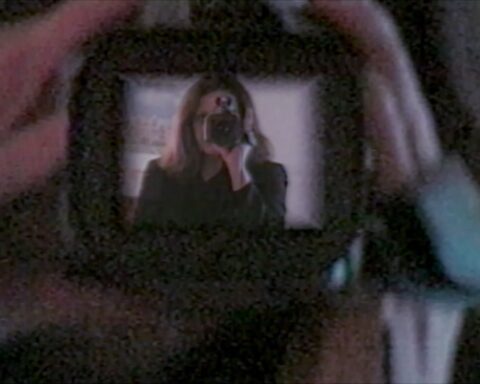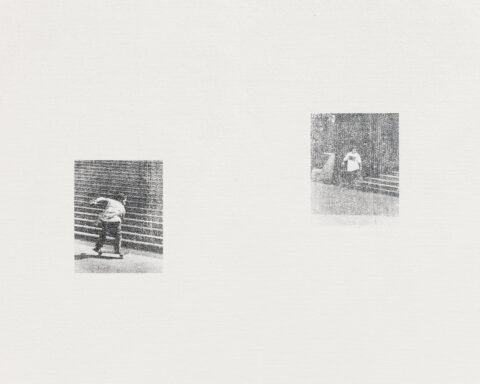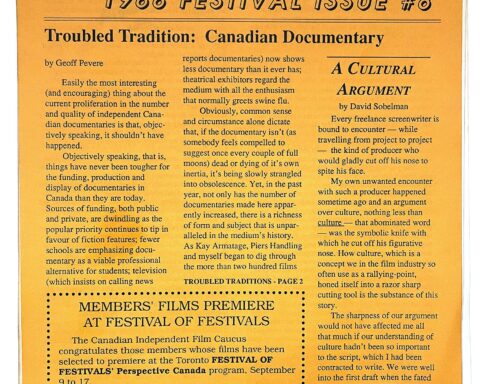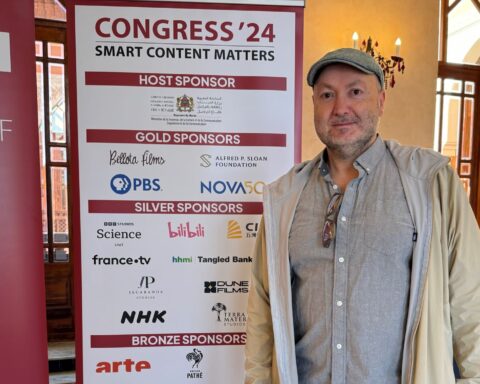The DVD release this June of Late Fragment, the first production of the Canadian Film Centre (CFC) Media Lab’s Interactive Narrative Feature Program, brings an extra laurel to the CFC’s twentieth-anniversary year. Made to be seen by home viewers rather than on a big screen, North America’s first interactive feature film follows three compelling individuals whose lives have been torn apart by acts of violence. Viewers switch scenes by clicking the remote at will, and thus become blindly complicit in cutting the film. The narrative is different for each viewer— a heady effect in a movie already complicated by partial confessions, and unreliable testimony. While three writer/directors wrote the interconnected stories that make up Late Fragment, acting as the Interactive Architect was Ana Serrano, the long-time Director of the CFC Media Lab.
Serrano has led the Lab since its inception in 1997, when a $500,000 grant from Bell MediaLinx enabled the CFC to convert an old stable (used until then as a film library) into a state-of-the-art media lab. Only 26, with a degree in English from McGill, and some postgraduate training in information architecture from U of T, Serrano had been working with Don Tapscott of Wikinomics celebrity. She had a keen instinct for anticipating the impact of emerging technologies on people’s lives— both economically and emotionally—and was immersed in ideas that even today would seem like heady futurism. “New media had a frontier feeling,” she says, “it was like we were cowboys in this completely open land, and I was right in the middle of the whole thing.”
The CFC intended to house a digital training program in their new electronic cottage, but at the time “digital” meant special effects for movies. Serrano pointed out to then executive director Wayne Clarkson that new technologies were themselves expressive media, and that the program should consider the future of culture and story, rather than service the film industry with producers of special effects. Furthermore, she noted, the CFC’s other training programs didn’t teach technical skills so much as content production, so the new media lab should follow suit. “Had Wayne not seen that this was a space where we should be experimenting with new forms of expression,” says Serrano, “there’s no way the Media Lab would have been born.”
With amazement, Serrano realized she was to design a training program for people just like herself: out of school, with some professional experience, searching for a fulfilling direction, and eager to explore the new electronic order. She was her own target client, and there were no similar programs anywhere in the world to use as models. “One of the best things that I ever did,” says Serrano, “was to admit that I needed help.”
She put together an international advisory board whose first member was celebrity designer David Carson, followed by MIT interactive cinema guru Gloriana Davenport, and acclaimed interactive theorist Janet Murray,
among others. Collaborators included faculty from academia who embraced the opportunity to escape the traditional institution. Much discussion determined that the course needed to expand and explore the scope and influence of new media, while enhancing the position of graduates within the new economy. The advisory board agreed that the program should involve teamwork, should interrogate narrative, and should form partnerships with business to nurture and sustain media projects and their creators. Serrano also gave the curriculum some weighty formal constraints.
“New Media values entailed a complete redefinition of how you ran things,” she says, “a rethinking of the hierarchical militaristic model of the organization.” To embody new media ideals, students needed to feel as much curricular ownership as faculty, and diversity needed to underpin its structure.
Serrano describes the resultant five-and-a-half month program as a cross between an art residency, technical training, and an MBA. Students spend the first third of the program in full-day training studying three modules: first, leadership, which combines individual self-discovery with a major emphasis on team-building; second, new media theory, history, politics, and aesthetics; and third, story, and narrative experience. In the last part of the program the students form groups and develop a prototype new media project.
As diverse as the students, only a few of these prototypes endure outside the program, but the ones that do hint of the myriad directions still to be explored at the Lab. Pax Warrior, the interactive documentary game, prototyped in 2001, immerses networked users in the decision-making quandaries faced by Romeo Dallaire and the UN peacekeeping mission in Rwanda. Designed for classroom use by 14-24 year olds, the game has been played by tens of thousands of students in Canada. Begun in a 1997 collaboration at the CFC Media Lab, Smiley Guy Studios produces Odd Job Jack and now employs over a hundred people in Toronto. LMNO Pics is either a platform or a focus on “art” or “entertainment.” How graduates decide to label their work has a lot to do with their choice of audience, but sometimes a project that fails with one audience will gain the attention of another. “As long as you can smell your own shit you will be able to figure out how to position yourself,” says Serrano. “At the end of the day, what we want to do at CFC Media Lab is make meaningful projects that actually have something to say, and have an internal logic that, more often than not, is satisfied through narrative.”
Now the Media Lab gets around 200 calls for each of its spring and fall intakes, educating about 18 to 20 people each year. The Centre vets each call and only accepts individuals who are prepared and ready to collaborate, a criterion that stems from new media values. This world view, or aesthetic of production, maintains that the more people involved in a project, the greater their chances of not only generating new ideas but also having them realized. Serrano feels that innovation today comes from the combination of many different skill sets—indeed the term “renaissance” as a descriptor in new media is common. A person might be very good at dreaming up magical ways to use a cellphone, but it might take the technical imagination of a wireless guru to put those dreams into practice. Most graduates of the program will tell you that the intense focus on collaboration and team-building can be time-consuming, difficult, draining, even heart-wrenching, but that it works: the groups come out stronger for having delved so deeply into the structure of their own ecosystem. By connecting peo- ple who have different ways of thinking about new technologies, and then teaching them how to work together, the Media Lab is accelerating innovation itself.
Team-building preoccupies Serrano so much that she’s reluctant to discount the success of groups that managed to form highly functional teams, without producing viable projects. The accomplishment of the program can be measured in the number of people it’s educated, who’ve had their perspectives on collaboration, new media, and narrative enriched. Not only does the Lab push out projects, it’s responsible for launching the careers of a new brand of cultural producer, one who occupies an odd place in the Canadian media industry. Rather than expanding to accommodate graduates of the program, however, Serrano worries that new media is losing ground in the Canadian cultural economy. The Canadian market can’t support many home-grown innovations, and there’s a cultural lack of interest in risk- taking. “All of which spells disaster for innovation,” exclaims an exasperated Serrano.
Some granting programs mitigate these roadblocks in the Canadian media economy, but platforms change rapidly, systems become obsolete, and in this milieu of technological churn, projects backed by deep American pockets face fewer challenges to survival than their Canadian counterparts. Prototypes created at the Lab rarely jumpstart new companies. Graduates find jobs using the skills they learned, or capitalize on the intellectual toolkit given them by the program, but usually don’t have the chance to see their projects grow. Even projects that enjoy widespread production often experience setbacks because the new media industry has not yet matured. For example, the Alberta school board has bought Pax Warrior, but the game rarely reaches students in other provinces because Canada has no distributors of “e-learning” products. These kinds of barriers have Serrano worried. “Are we doing our graduates a disservice,” she wonders, “by saying you should make innovative things, when making innovative things in this country may not help you pay the bills?”
The question hangs unanswered in the air, and contains an undefined further question about the validity of the projects themselves: what is their value if the Canadian public doesn’t want to buy them yet? So much avant-garde art never pays until its producers are dead, but in the design world, if something is good, it sells. Period. Attractiveness to consumers is a measure of success. “But at the same time,” continues Serrano, “well, someone’s got to be doing this stuff!” And someone will, whether the Media Lab fosters the work now, or the interactive language evolves on its own in the wild. Overall, in Ana’s words, “successful residents are the ones who understand the need to educate their audiences and clients in why they need to invest in them.”
With its training wing established, the Media Lab turned its sights on interactive cinema, which had always hovered as an ambition in its peripheral vision. Previously the objective had been unrealistic because of the turbulence in audiovisual platforms. The Centre only wanted to undertake a project that would have a potential revenue model, a condition made impossible without a marketable delivery platform. Once DVD became the mainstream video technology of choice, that concern was eliminated and the Interactive Narrative Feature Program (INFP) could begin in earnest.
Due to the Media Lab’s self-conscious obsession with collaboration, the screenplay of North America’s first interactive film Late Fragment went through an unlikely gestation. The project had received a major grant for an application that promised a film produced by three writer/director teams, whom Serrano thought would be able to write the central story together. When the first group hired by Serrano disintegrated, she realized that she needed to construct a process that could make the delicate task of collective authorship possible. The heart of the project solidified when Serrano learned about Restorative Justice, a prison-based rehabilitation method that brings perpetrators and victims of violent crime together for group therapy sessions—a perfect premise of high-stakes interaction for an interactive film. As the film came together she also took on the creative position of “Interactive Architect,” but maintains that the role was mainly synthesizing the group’s own critiques of nine different drafts of the interactive structure. “Ultimately,” she says, “someone had to pin the bits of paper to the wall!” Since a debut at the Toronto International Film Festival last fall, Late Fragment has shown at SXSW (South by South West Festival) in March, and at Cannes in May. Mongrel Media releases the DVD of this collaboration between the NFB and the CFC in June.
Focusing on the need for local engagement in order to bring about change, the next project in development by the INFP will combine a musical drama in the vein of last year’s Irish Once, an open blog, and an online interactive documentary. Far from perpetuating the stereotype of the remote-control gripping basement potato, the CFC’s interactive films aim to inspire viewers to take their voices to the street. This interest in engagement, Serrano maintains, is at the forefront of new media art today. “Back in 1997 we thought interactive meant buttons. Now the design language is fairly mature, so we can begin to go deeper. New media art now is all about cognitive interactivity, about interpretation, and what it means to engage in a meaningful way.”











